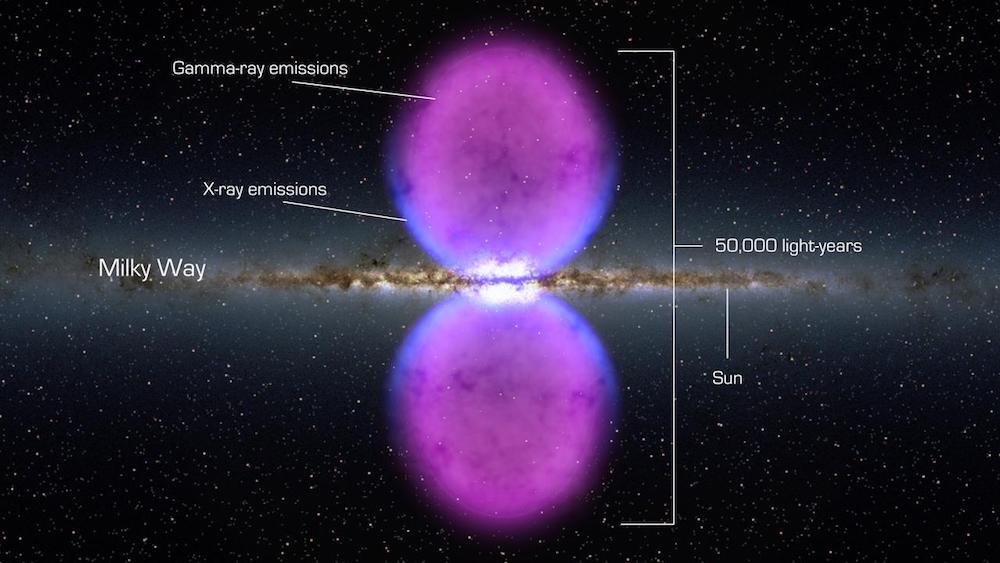These Two Cosmic 'Chimneys' Could Be Fueling the Galaxy-Sized Bubbles Looming Over the Milky Way

The supermassive black hole at the center of our galaxy is a bit like the hearth at the center of a cozy pub. It's a bright, warm gathering place around which all the quotidian life of the Milky Way swirls — and, according to a new study published today (Mar. 20) in the journal Nature, it might even have a chimney or two.
In a recent study of the X-ray emissions seething out of the Milky Way's galactic center, researchers noticed two unusual structures that have never been described before. Twin columns of superhot, X-ray-emitting plasma appeared to be billowing out of the galactic center, one rising north and the other flowing south, for hundreds of light-years in either direction.
"We call these the chimneys," lead study author Gabriele Ponti, a researcher at the National Institute for Astrophysics (INAF) in Italy, told Live Science. "Looking at them, we see clear evidence for a strong outflow of plasma from the galactic center." [The 12 Strangest Objects in the Universe]
X-ray marks the spot
Ponti and his colleagues found this evidence by analyzing more than 750 hours of X-ray observations taken by the XMM-Newton and Chandra telescopes. These observations helped the team create an X-ray map of the center of the Milky Way (shown above), including the near-symmetrical chimney plumes emanating from either side of Sagittarius A*, the bright fount of radio waves believed to shroud our galaxy's supermassive black hole.
Both the northern and southern chimneys extend about 522 light-years over the galactic center, and each gets hotter and denser the closer they are to Sagittarius A*. It seems clear that these blasts of heat and matter are the result of some large outflow from the galactic center, Ponti and colleagues wrote, though the exact source is unknown. The available evidence points to two possibilities: Either the outflow is being caused by the supermassive black hole itself (which may be slingshotting some matter into space even as it gobbles up huge amounts of nearby gas and dust) or else by periodic supernova explosions occurring throughout the galaxy's central star cluster.
"The data supports both these scenarios," Ponti said.
Blowing cosmic bubbles
The chimneys' final destination, meanwhile, seems clearer than their origin.
Get the world’s most fascinating discoveries delivered straight to your inbox.
In their X-ray map, the researchers saw that both the northern and southern chimneys extend into the bases of two gargantuan structures known as the Fermi bubbles — essentially, two giant cavities of gas and cosmic rays carved from the galactic center by millions of years of activity.
Since 2010, scientists have known our galaxy is blowing space bubbles and think they were likely created by some turbulent event at the galaxy's center several million years ago. However, according to Ponti, the discovery of the galactic chimneys marks the first direct connection between these massive, gassy orbs and the Milky Way's relatively tiny core.
"The chimneys are the exhaust pipes connecting the activity of the galactic center with the Fermi bubbles," Ponti said.
Further study of the chimneys could reveal a more precise origin of the Fermi bubbles. The next step, Ponti said, is imaging an even wider section of the galactic center — to see, for example, if the chimney flow seems localized over the galaxy's supermassive black hole, or if it is spread out over a wider cluster of stars. Either way, the hearth at the center of the galaxy will keep a fire burning for us — perhaps a larger one than anyone imagined.
- 9 Strange Excuses for Why We Haven't Found Aliens Yet
- 15 Amazing Images of Stars
- Rainbow Album: The Many Colors of Earth's Sun
Originally published on Live Science.

Brandon is the space / physics editor at Live Science. With more than 20 years of editorial experience, his writing has appeared in The Washington Post, Reader's Digest, CBS.com, the Richard Dawkins Foundation website and other outlets. He holds a bachelor's degree in creative writing from the University of Arizona, with minors in journalism and media arts. His interests include black holes, asteroids and comets, and the search for extraterrestrial life.



